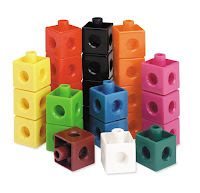- Grade 7 - determine, through investigation using a variety of tools and strategies (e.g., decomposing right prisms; stacking congruent layers of concrete materials to form a right prism), the relationship between the height, the area of the base, and the volume of right prisms with simple polygonal bases (e.g., parallelograms, trapezoids), and generalize to develop the formula (i.e., Volume = area of base x height).
- Grade 8 - determine, through investigation using a variety of tools and strategies (e.g., generalizing from the volume relationship for right prisms, and verifying using the capacity of thin-walled cylindrical containers), the relationship between the area of the base and height and the volume of a cylinder, and generalize to develop the formula (i.e.,Volume = area of base x height). Note: though there isn't a direct connection to the cylinder here, since a cylinder is a prism (circular prism), it will adhere to this relationship.
- 2cm snap cubes (each student or pair of students will need up to 60)
- photocopy of the grid handout for each student or pair of students. Note that when you copy or print this out, make sure that the check box "fit" is selected to maximize the size of the grid making the squares the same size as the snap cubes. You may want to verify this before printing a bunch out for the class
- If you are doing this virtually, then you might want to have them actually build their shapes using this virtual manipulative.

- Students are first given a blank grid and asked to trace two non rectangular shapes of different areas (no diagonals) using the grid lines.
- Once they have their shapes they should determine the area (in units2) of each shape and enter that in their table.
- Students then take the cubes and connect them to create a 3D shape to match the profile of their drawn shapes (1 unit high).If you are doing this virtually, then you might want to have them actually build their shapes using this virtual manipulative.
- Students can then determine the volume of each shape (in units3) by counting the cubes used and enter those values in the table
- Next increase the height of each shape by one unit, determine the volume by counting the cubes and enter those values in the table.
- Repeat step 5 so that the shapes are now 3 units high.
- Students are then to look for a connection between the height, area of the shape (base) and the volume and use that relationship to predict the volume of a shape that is 6 units in height (without building it). Students will hopefully see that the volume can be found by multiplying the area of the base times the height.
- Generalize the relationship (Volume = area of the base x height) and have students complete this worksheet to practice. For a Desmos version, click here.

Did you use this activity? Do you have a way to make it better? Did you find a mistake? If so tell us in the comment section. Thanks
























